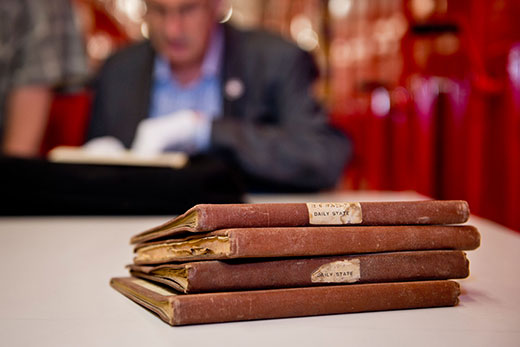For generations it has been believed that about 8556 Kiwi soldiers served at Gallipoli in 1915, but recent research has shown that estimate was quite wrong.
It is more likely to have been 16,000 and that figure is considered to be a conservative estimate as researchers now know that more than 20,000 New Zealand soldiers arrived in the Middle East in time to take part in the campaign.
The meticulous notebooks of the Australian and New Zealand Division's Deputy Assistant Adjutant General which is kept in Archives New Zealand raised the number of Kiwis at Gallipoli. Photo: Supplied
The total number who served in Gallipoli may have exceeded 17,000.
The lower number comes from General Sir Ian Hamilton's preface to the official history of the Gallipoli campaign, written in 1919.
Digitisation of WWI records by NZ Archives has enabled Chief Historian Neill Atkinson to analyse thousands of individual military service files, many of which proved incomplete.
He found that official diaries and information on troop movements gave a much better idea of the numbers involved.
The breakthrough came with the discovery of notebooks of the Deputy Assistant Adjutant General of the Australian and New Zealand Division.
'These meticulously kept records detail the movements of Australian and New Zealand Division soldiers on and off the Peninsula during June, July and August 1915 and meant we could calculate the total numbers with a much higher accuracy,” NZDF Historian John Crawford says.
The research initially looked at 2,429 service records of the 6th Reinforcements, the last reinforcement to reach Egypt before the end of the 1915 Gallipoli campaign.
This analysis showed that at least 76 per cent of these men served at Gallipoli.
Cross-referencing unit administrative files and a search for other relevant material, including the recently-rediscovered DAAG's notebooks, followed.
The final figure was reached by adding the results of the 6th Reinforcement research, the numbers estimated to be present in April-May 1915, and the numbers from the DAAG's notebook research.
The research methodology was overseen by Statistics New Zealand.
'This figure is by no means final but it's the most accurate we can achieve using the evidence we have discovered to date,” says Crawford.
The total number of Kiwi deaths at Gallipoli is not being revised and remains the same at 2,779.
In his preface to Major Fred Waite's 1919 official history, The New Zealanders at Gallipoli, General Sir Ian Hamilton seems to have been referring only to the first few units to land at Gallipoli in April-late May 1915. Hence the old number of 8,556.
Later in the book, Waite made it clear that this number did not include the reinforcements that were later sent to the peninsula.
Since the early 1980s, historians have questioned the 8,556 figures and how it was calculated. Producing a more definitive estimate, however, was made difficult because of the fragmentary nature and relative inaccessibility of many of the known sources.
The digitisation of First World War military service files by Archives New Zealand in 2014 has dramatically increased the number of records that could be easily accessed to address this question.
A total of six reinforcement contingents embarked from New Zealand for service overseas and arrived in the Middle East in time to serve during the Gallipoli campaign.
The Deputy Assistant Adjutant General was Lieutenant-Colonel Nathanial William Benjamin Butler Thoms,who was born in England on 5 April 1880. He served with the British forces in the South African War between 1900 and 1902.
In 1911 he was commissioned as a Lieutenant in the New Zealand Staff Corps. He was amongst a significant group of British officers brought out to New Zealand by Major-General Alexander Godley to help with the establishment of the new military organisation in the Dominion.
Thoms was commissioned in the New Zealand Expeditionary Force (NZEF) as a captain on 5 August 1914 and landed on Gallipoli at the start of the campaign and was promoted to major in September 1915.
As Deputy Assistant Adjutant General of the New Zealand and Australian Division, an important staff post at the headquarters of the division, he was responsible for personnel matters. As part of this role he was responsible for keeping an accurate record of the division's strength on a day-by-day basis.

Meticulously kept records detail the movements of Australian and New Zealand Division soldiers on and off the Peninsula during June, July and August 1915. Photo: Supplied



0 comments
Leave a Comment
You must be logged in to make a comment.